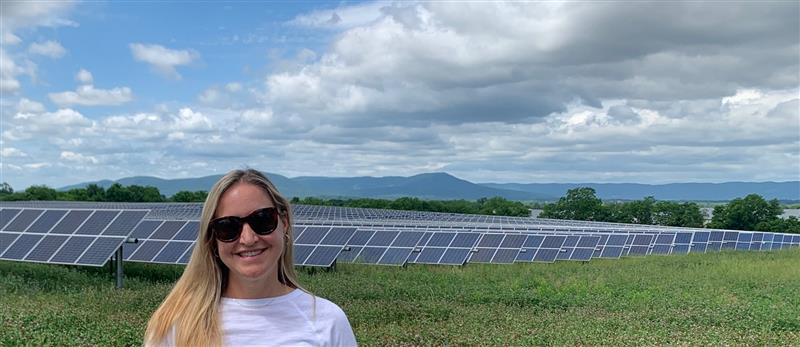The Responsible Solar Approach part 3: Soil health & biodiversity
Third article in a series by Alyssa Edwards, Senior Vice President, Environmental Affairs and Government Relations:
Solar farms can grow a lot more than electricity.
Conventional wisdom has it that the only thing a solar farm can grow is electricity. But we’ve found that layering in additional benefits creates conditions where both the developer and the community can thrive. That starts with investing in soil health and biodiversity.
Unlike residential and retail development, solar preserves much of the land below projects. The soil around and under the panels can support plants to reduce erosion and attract the insects needed to pollinate nearby crops.
Introducing renewable energy projects to skeptical communities requires more than soothing platitudes. It requires evidence, good faith and a track record of demonstrated results. These steps may cost a little more, but they build community acceptance and goodwill that make the investment worthwhile.
The needs are clear: The climate crisis requires us to triple solar development to reach 30% of U.S. electricity generation by 2030 — that is almost 125 GW a year. Reaching that goal means overcoming local opposition. We’re taking extra steps to be good stewards: improving soil health and promoting biodiversity to nurture community support.
Soil health
At first blush, it seems that a solar farm can cover a lot of previously unused acreage, but its footprint is actually lighter than other land uses. A subdivision or strip mall, for example, permanently transforms the land, while solar arrays can accommodate other land uses while also generating power. At the end of a solar farm’s useful life, its pilings and equipment are easily removed.
The “most underappreciated quality of solar power is that the land is ‘preserved’ for 30 years, and allowed to regenerate,” Lightsource bp CEO Kevin Smith said in a comment on my last article. “At the end of the 30 years, if the best use of the land is to return to farming, the facility can be removed, leaving a clean and enriched site ready for planting.”
Preserving farmland and promoting soil health means keeping soil available and healthy for future generations. For example:
- Rest and recuperation. Solar farms developed on agricultural land are often on acreage that has been cultivated for decades. At the very least, the land’s use as a solar farm will give the soil a chance to rest, a practice similar to farmers who allow some of their acreage to lie fallow for a few growing seasons.
- Vegetation that generates nutrients and prevents erosion. At two of our solar farms in Pueblo, Colorado, Lightsource bp is conserving thousands of acres of native shortgrass prairie habitat. These revegetation projects can boost carbon sequestration, reduce water runoff, and enhance soil stabilization – as well as provide important habitat for wildlife.
Biodiversity
Soil health and preservation also happens simultaneously with efforts to encourage biodiversity. Consider:
- Pollinators. Around the country, pollinator species are at risk from pollution, development and other threats. But well-curated vegetation provides a productive habitat for bees and other pollinator species, which will pollinate nearby farms. The bees can also produce honey, providing additional revenue streams for landowners.
- Helping other farms. In Pueblo County, CO for example, there are local farms that depend on bees and other pollinating insects to thrive. The presence of pollinators is known to increase crop yield, and one study showed that wildflower plantings adjacent to agricultural fields increased wild pollinator abundance. The total benefit of native insect pollination has been estimated at more than $9 billion per year.
- Creating new habitats. To support reptile and lizard habitat we built five hibernacula at Lightsource bp’s Impact Solar site in Texas. These consist of an underground hole, backfilled with rocks and covered with logs and soil to mimic nature. Large open spaces can be difficult places to live for lizards and other small reptiles, so these simple structures provide a haven.
Leverage local expertise and research
These steps aren’t cookie-cutter plans. They’re developed with local experts and farmers to develop the practices that work best in their community. We utilize research, ecological surveys and we gather feedback from the community to create a tailored plan for each site.
Establishing those local connections enhances support and makes each solar project a trusted and vital part of their community.
Soil and biodiversity best practices can have a positive cumulative effect on the environment. That could mean planting native hedgerows, shrubs and trees around the edge of a field or adding bug hotels, open drainage structures, nesting and roosting boxes, log piles, ditches or ponds.
Our experiences show these strategies work. Every site is different, and not all locations can take every measure, but a thoughtful approach to siting and development will generate cumulative benefits.
It’s important to share what we’ve learned with the wider community. Respondents to government inquiries show a consensus that more research is needed to develop strategies for habitat and vegetation management at solar farms. Research findings can benefit the entire solar industry as it strives to create more clean energy.
This article is the third in a series exploring how best practices in environmental and land management increase community acceptance and enhance the surrounding environment. Alyssa Edwards first published this article on LinkedIn in on June 8, 2022. To leave a comment or question, please view the original post here.
Related news
03 Apr, 2025
Community hospital check presentation, job fair kick off Lightsource bp Jones City energy center in Jones County, Texas
Community partnerships in Texas
26 Mar, 2025
Lightsource bp solar project in Louisiana goes online, driving US manufacturing and local economic growth
180MW project in Louisiana




